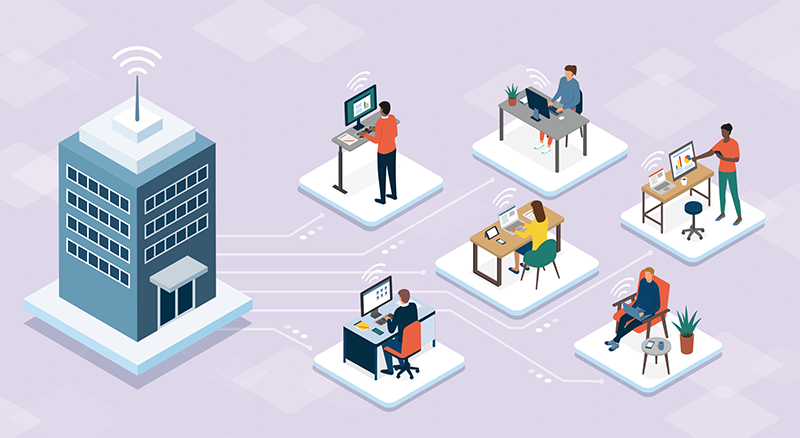Introduction
Technology and shifting attitudes towards
workplace flexibility have been driving forces behind a dramatic shift in the
nature of employment in the last several years. The rise of hybrid work arrangements
and the broad acceptance of remote work are two of the most noticeable changes
Remote Work and the Rise of the Hybrid Workforce
Remote Work: A Paradigm Shift
Working
away from a typical workplace, typically from one's home or another distant
location, is called remote work, telecommuting, or telework. Global adoption of
remote work was sped up by the COVID-19 pandemic, which prompted organizations
to swiftly adjust their strategies to prioritize employee safety while ensuring
company continuity
The
benefits of working remotely are numerous. Employees have more control over
their work schedules, transportation is less expensive and time-consuming, and
businesses may tap into a larger pool of talent regardless of their location.
Furthermore, working remotely encourages a healthier work-life balance, which
in turn boosts job satisfaction and retention.
Having
said that, there are difficulties associated with remote employment as well. A
major worry is that team members may stop talking to each other and working
together, which might make them feel lonely and weaken their band together.
Plus, without face-to-face contact and direct supervision, it might be
difficult to keep productivity and quality of work uniform.
The Rise of the Hybrid Workforce
Many
companies are moving towards hybrid work models, which combine in-office and
remote work, since they see the value in both. A hybrid workforce allows
workers more freedom to pick their work environment according to personal
preferences and job demands by combining remote and regular office employment.
By
allowing for more in-person interactions, encouraging teamwork, and preserving
a feeling of company culture, the hybrid approach mitigates some of the
negative aspects of remote work. Additionally, businesses may maximize the use
of their office space, cut expenditures elsewhere, and help the environment by
reducing emissions caused by employees' commutes.
It
does, however, need meticulous preparation and execution to manage a mixed
workforce well. In order to facilitate effective communication and cooperation
between remote and in-office workers, businesses need put money into the
necessary technological infrastructure. In addition, they should teach
employees on the best practices for remote work, set clear expectations for
availability and work hours, and provide clear lines of communication
Navigating Challenges and Maximizing Benefits
To
navigate the challenges associated with remote work and hybrid workforce
models, organizations must prioritize several key factors. These include:
|
Technology
Integration |
Creating
powerful communication and collaboration platforms that enable remote and
in-office teams to hold virtual meetings, share documents, and collaborate in
real-time. |
|
Flexible
Policies |
Consistency,
fairness, and labour productivity may be achieved through the development of
flexible rules that cater to varied work preferences. |
|
Leadership
and Management: |
Providing
managers with the tools they need to build trusting, accountable cultures,
encourage team unity, and manage performance in hybrid teams. |
|
Employee
Well-being |
Providing
remote and hybrid workers with wellness programmes, tools, and assistance to
proactively address issues like burnout, loneliness, and work-life balance. |
Figure 1Navigating challenges and Maximizing Benefits
Conclusion
Organizational approaches to work and employee engagement are undergoing a fundamental transition with the rise of remote work and hybrid workforce models. Although these models have many advantages, they also pose some problems that need for leaders to be proactive and make smart decisions.
The
full potential of remote work and hybrid workforce models can be realized when
organizations embrace technology, establish flexible policies, foster strong
leadership, and prioritize employee well-being. The end goal of this change is
to make the organization more resilient to changes in the workplace, happier
employees, and more productive overall.
References
Alexander, A., De Smet, A. & Mysore, M., 2020.
Reimagining the postpandemic workforce. McKinsey Quarterly, p. 3.
Griffiths, M., 2015. Creating the hybrid workforce:
challenges and opportunities.. Journal of Medical Imaging and Radiation
Sciences, , 46(3), pp. 262-270..
Hilberath, C. et al., 2020. Hybrid work is the new
remote work. Melbourne: Boston consulting group..
Sokolic, D., 2022. Remote work and hybrid work
organizations.. Book of proceedings ed. s.l.:Economic and social
development.
Tahlyan, D. et al., 2024. In-Person, Hybrid or Remote?
Employers' Perspectives on the Future of Work Post-Pandemic. p. 2402.18459.

Remote work and hybrid models offer flexibility and autonomy, enhancing work-life balance and productivity. However, they require robust communication tools and strategies to maintain cohesion. By embracing these approaches, organizations can adapt to changing work dynamics and attract top talent globally.
ReplyDeleteThank you for your valuable comment.
ReplyDeleteA new Trend in workplaces explained nicely
ReplyDelete